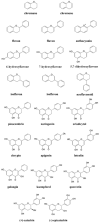Metal-Flavonoid Interactions-From Simple Complexes to Advanced Systems
- PMID: 38893449
- PMCID: PMC11173564
- DOI: 10.3390/molecules29112573
Metal-Flavonoid Interactions-From Simple Complexes to Advanced Systems
Abstract
For many years, metal-flavonoid complexes have been widely studied as a part of drug discovery programs, but in the last decade their importance in materials science has increased significantly. A deeper understanding of the role of metal ions and flavonoids in constructing simple complexes and more advanced hybrid networks will facilitate the assembly of materials with tailored architecture and functionality. In this Review, we highlight the most essential data on metal-flavonoid systems, presenting a promising alternative in the design of hybrid inorganic-organic materials. We focus mainly on systems containing CuII/I and FeIII/II ions, which are necessary in natural and industrial catalysis. We discuss two kinds of interactions that typically ensure the formation of metal-flavonoid systems, namely coordination and redox reactions. Our intention is to cover the fundamentals of metal-flavonoid systems to show how this knowledge has been already transferred from small molecules to complex materials.
Keywords: flavonoids; hybrid materials; redox; transition metals.
Conflict of interest statement
The authors declare no conflicts of interest.
Figures









Similar articles
-
Metal Ion-Directed Functional Metal-Phenolic Materials.Chem Rev. 2022 Jul 13;122(13):11432-11473. doi: 10.1021/acs.chemrev.1c01042. Epub 2022 May 10. Chem Rev. 2022. PMID: 35537069 Review.
-
Antioxidant vs. Prooxidant Properties of the Flavonoid, Kaempferol, in the Presence of Cu(II) Ions: A ROS-Scavenging Activity, Fenton Reaction and DNA Damage Study.Int J Mol Sci. 2021 Feb 5;22(4):1619. doi: 10.3390/ijms22041619. Int J Mol Sci. 2021. PMID: 33562744 Free PMC article.
-
Interactions of Native Cyclodextrins with Metal Ions and Inorganic Nanoparticles: Fertile Landscape for Chemistry and Materials Science.Chem Rev. 2017 Nov 22;117(22):13461-13501. doi: 10.1021/acs.chemrev.7b00231. Epub 2017 Oct 19. Chem Rev. 2017. PMID: 29048880 Review.
-
Transition Metal Coordination Complexes of Flavonoids: A Class of Better Pharmacological Active Molecules to Develop New Drugs.Anticancer Agents Med Chem. 2023;23(4):417-431. doi: 10.2174/1871520622666220520093018. Anticancer Agents Med Chem. 2023. PMID: 35619308 Review.
-
Expanding the Rare-Earth Metal BINOLate Catalytic Multitool beyond Enantioselective Organic Synthesis.Acc Chem Res. 2021 Jun 1;54(11):2637-2648. doi: 10.1021/acs.accounts.1c00148. Epub 2021 May 20. Acc Chem Res. 2021. PMID: 34014657 Review.
Cited by
-
Quercetin•Zirconium Metal Complexes: Insights from Femto to Millisecond Photobehavior.Chemistry. 2025 Jun 23;31(35):e202500854. doi: 10.1002/chem.202500854. Epub 2025 May 22. Chemistry. 2025. PMID: 40354135 Free PMC article.
-
Nanotechnology in Osteogenesis and Inflammation Management: Metal-Organic Frameworks, Metal Complexes, and Biomaterials for Bone Restoration.Biomedicines. 2025 Jun 30;13(7):1597. doi: 10.3390/biomedicines13071597. Biomedicines. 2025. PMID: 40722669 Free PMC article. Review.
-
Drosera rotundifolia L. as E. coli biofilm inhibitor: Insights into the mechanism of action using proteomics/metabolomics and toxicity studies.Biofilm. 2025 Feb 28;9:100268. doi: 10.1016/j.bioflm.2025.100268. eCollection 2025 Jun. Biofilm. 2025. PMID: 40124935 Free PMC article.
-
Biology, Antioxidant Activity, and Therapeutic Potential of Cistus sp.-A Comprehensive Review.Int J Mol Sci. 2025 Jul 3;26(13):6400. doi: 10.3390/ijms26136400. Int J Mol Sci. 2025. PMID: 40650177 Free PMC article. Review.
-
Functional, Structural and Genetic Modulation in Plasma and Renal Antioxidant Systems by Quercetin, Catechin and Genistein in Cisplatin-Induced Acute Nephrotoxicity in Wistar Rats.Food Sci Nutr. 2025 Aug 11;13(8):e70680. doi: 10.1002/fsn3.70680. eCollection 2025 Aug. Food Sci Nutr. 2025. PMID: 40801052 Free PMC article.
References
-
- Engel E.R., Engel E.R., Scott J.L. Advances in the Green Chemistry of Coordination Polymer Materials. Green Chem. 2020;22:3693–3715. doi: 10.1039/D0GC01074J. - DOI
Publication types
Grants and funding
LinkOut - more resources
Full Text Sources

